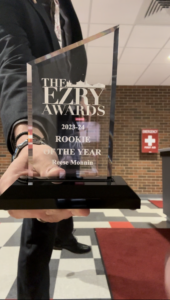On Wednesday, Feb. 22, Wittenberg’s history department sponsored a colloquium event in Shouvlin 105. Marica Cassis, an archaeologist and professor of history from Memorial University of Newfoundland, delivered the lecture, which focused on Çadir Höyük, an archaeological site in central Turkey.
Cassis is the director of Byzantine excavations on the small, rural location. Excavations there started as a salvage project to rescue artifacts from potential flooding. As the layers of artifacts from different periods continued, the discoveries made Çadir Höyük a cornerstone for historical dates.
“We have a tendency in Byzantine history to retell the same stories,” Cassis said. “What were ordinary people doing?”
Even so, Çadir Höyük serves as a unique and interesting case study of everyday life in the Byzantine Empire throughout its history, even during periods about which little is known. For example, the time between the mid-sixth century and mid-ninth century is referred to as the Byzantine Dark Ages because written sources are nonexistent and artifacts from that time are hard to identify. This is in part because early archaeologists of the ‘20s and ‘30s dug beneath and discarded the layers Cassis currently studies. Archaeologists did this to reach the Roman artifacts they preferred. This damaged the artifact layers at other sites, and by extension, the ability to create an accurate calendar of events. However, Çadir Höyük was not previously excavated and so its artifacts remained undisturbed until recently. In spite of the wealth of objects found, there are no grounds for comparison as to whether the findings of rural life at Çadir Höyük are normal or an anomaly.
The terraced dig site, which existed at the earliest during the Roman Empire, is home to the remnants of a small rural villa of some wealth, close to trade routes or roads that existed at the time. Artifacts found at the sight include functional items, like an axe, and small religious items, such as a cross. These are representative of the everyday lives of those who were a part of the site’s history.
Cassis also described the discovery of the remnants of a locked stable in her lecture; the animal remains inside indicated that, although the remains were older and diseased, the animals had been locked up and left to die. A few human skeletons were found as well, still in possession of their armor. There is no concrete evidence to suggest what kind of event occurred or who was responsible for it. This site’s history ended around the eleventh century.
Cassis concluded her lecture about the site and the most recent season’s finds by answering questions from the audience. During the Q&A session, the audience learned that a typical dig lasts six to eight weeks. The length of the dig is small compared with the required paperwork to study Çadir Höyük, which is extensive. One of Cassis’ colleagues at the University of Chicago holds an actual permit for the site. Every November, the permit and a request to study the site is submitted to the Turkish Government. The dig team is notified of its acceptance in June, and another round of paperwork is required once they have arrived in Turkey. A government official stays with the team on the dig site while they work.





